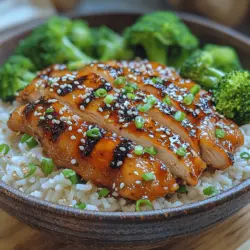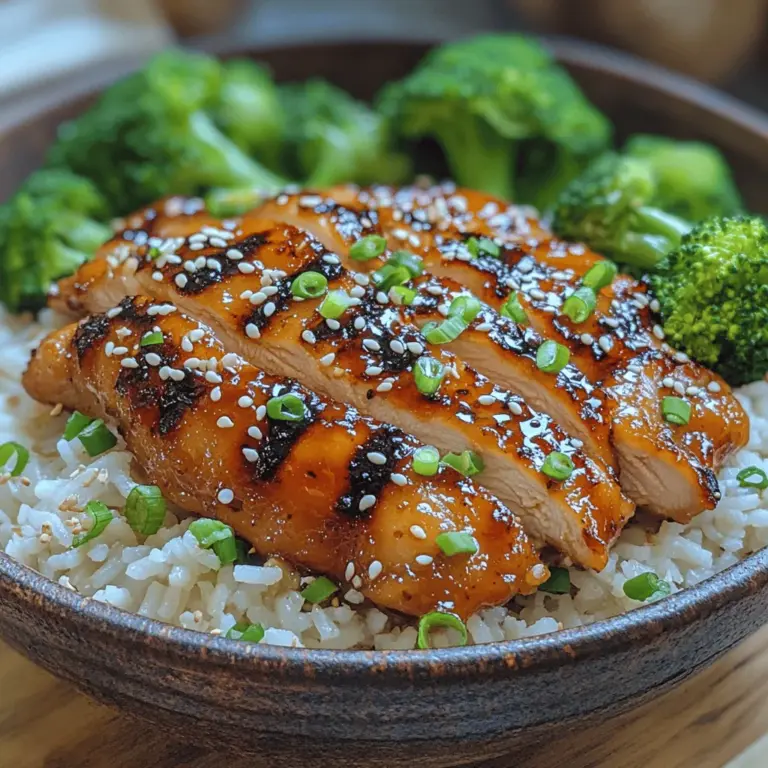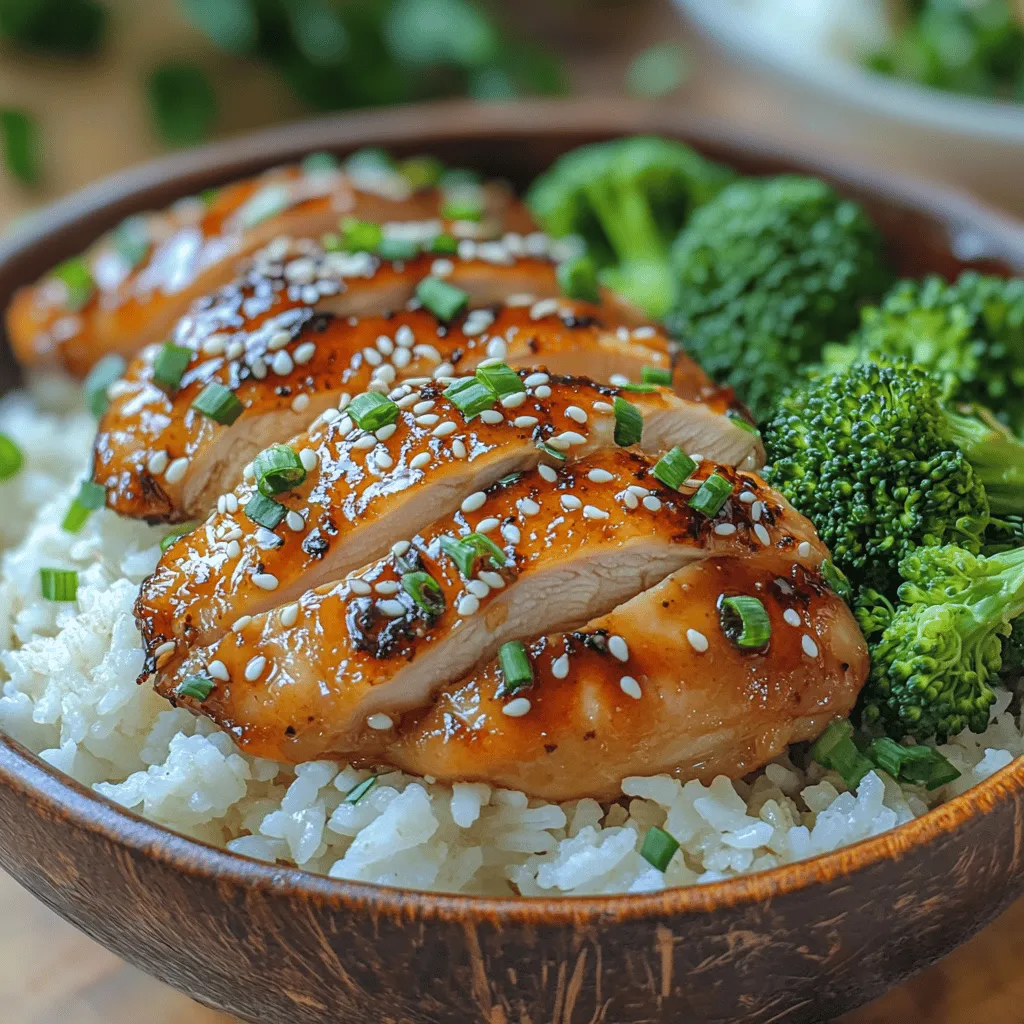Introduction
If you’re on the lookout for a delicious and health-conscious meal, look no further than Teriyaki Bliss Chicken with Coconut Aminos. This dish marries the sweet and savory flavors of traditional teriyaki with a modern twist that caters to various dietary preferences. The use of coconut aminos as a soy sauce substitute not only enhances the dish’s flavor profile but also makes it a healthier option, especially for those watching their sodium intake.
Teriyaki Bliss Chicken is more than just a meal; it’s a culinary experience that brings together rich flavors, healthy ingredients, and versatility. Whether you’re serving it over a bed of rice, tossing it into a vibrant stir-fry, or enjoying it cold in a salad, this chicken dish adapts beautifully to your needs. Its appeal stretches across various diets, including paleo, gluten-free, and low-sodium.
In this article, we’ll delve into the flavors that define Teriyaki Bliss Chicken, the nutritional benefits of using coconut aminos, and how to prepare this mouthwatering dish in your own kitchen.
Understanding Teriyaki Bliss Chicken
Teriyaki is a cooking technique that hails from Japan, where ingredients are grilled or broiled and glazed with a sweet soy sauce marinade. The classic teriyaki flavor profile consists of a beautiful balance of sweetness, umami, and a touch of acidity, often achieved through the inclusion of ingredients like soy sauce, sake, and sugar. When creating Teriyaki Bliss Chicken, we embrace these traditional elements while introducing coconut aminos, a fantastic alternative to soy sauce that enhances the dish in a healthy way.
Traditional Teriyaki Sauces vs. Coconut Aminos
Traditional teriyaki sauces are typically made with soy sauce, which is high in sodium and may not be suitable for everyone. Coconut aminos, derived from the sap of coconut blossoms, contains significantly less sodium and is gluten-free, making it an excellent substitute for those with dietary restrictions. The flavor of coconut aminos is slightly sweeter and less salty than soy sauce, which allows for a more nuanced flavor profile in your teriyaki chicken.
Nutritional Benefits of Coconut Aminos
Coconut aminos are not just a lower-sodium alternative; they also come with additional health benefits. Unlike soy sauce, which can be highly processed, coconut aminos are often raw and organic, containing essential amino acids and antioxidants. This makes them a great addition to your diet, allowing you to enjoy the traditional flavors of teriyaki without the health drawbacks of soy sauce.
The Role of Honey or Maple Syrup in Balancing Flavors
To achieve the perfect teriyaki glaze, the sweetness of honey or maple syrup plays a crucial role. Honey offers a rich, floral sweetness, while maple syrup provides a unique, earthy flavor. Both options contribute to the overall balance in the dish, complementing the savory notes from the coconut aminos and the richness of the chicken thighs. Depending on your dietary preferences or what you have on hand, you can choose one over the other for your Teriyaki Bliss Chicken.
Ingredients Breakdown
Creating Teriyaki Bliss Chicken requires a handful of key ingredients that come together to deliver a mouthwatering dish. Let’s break down the main components and their nutritional insights.
Key Ingredients
1. Chicken Thighs: The star of this dish is, without a doubt, the chicken thighs. Known for their tenderness and richer flavor compared to chicken breasts, thighs are an excellent source of protein. They also contain healthy fats, which help keep you satiated and contribute to a well-rounded meal.
2. Coconut Aminos: As discussed, coconut aminos serve as a low-sodium alternative to soy sauce. This ingredient not only adds flavor but also helps enhance the dish’s nutritional profile, making it suitable for those looking to reduce their sodium intake.
3. Honey or Maple Syrup: The sweetener of choice plays a pivotal role in achieving the perfect glaze. Honey is packed with antioxidants and has antibacterial properties, while maple syrup is a good source of minerals like manganese and zinc.
4. Garlic and Ginger: Fresh garlic and ginger add depth and complexity to the flavor of the teriyaki sauce. Both ingredients have anti-inflammatory properties and contribute to overall health, making them essential components of this dish.
Nutritional Insights for Each Main Ingredient
– Chicken Thighs: Approximately 26 grams of protein per 100 grams, providing essential amino acids for muscle repair and growth.
– Coconut Aminos: Contains about 90% less sodium than soy sauce, making it a heart-healthy option.
– Honey: Contains about 64 calories per tablespoon and provides natural energy, along with antioxidants.
– Maple Syrup: Contains around 52 calories per tablespoon and is rich in minerals and vitamins, such as riboflavin and zinc.
– Garlic and Ginger: Low in calories but high in flavor, these ingredients also offer health benefits, including improved digestion and a boost to the immune system.
Importance of Fresh Ingredients
Using fresh ingredients is crucial for maximizing flavor and nutrition in Teriyaki Bliss Chicken. Fresh garlic and ginger not only enhance the taste but also ensure that you’re getting the most health benefits from your dish. While dried spices can be convenient, nothing compares to the vivid flavor and aroma of freshly minced garlic and ginger.
The Marination Process
Marinating is an essential step in preparing Teriyaki Bliss Chicken, as it allows the flavors to penetrate the meat, resulting in a dish that is bursting with taste. Here’s how to achieve the perfect marination.
Detailed Explanation of Marinating Chicken for Flavor Infusion
To marinate chicken thighs, create a mixture of coconut aminos, honey or maple syrup, minced garlic, and grated ginger. The marinade should be well-balanced, ensuring that each ingredient complements one another without overwhelming the others. The chicken should be submerged in the marinade for at least 30 minutes, although longer marinating times will yield even more flavor—up to 24 hours is ideal.
Tips for Effective Marination
1. Time: While a minimum of 30 minutes is recommended, marinating overnight will allow the flavors to develop even further. This is especially important if you are using thicker cuts of meat like chicken thighs.
2. Temperature: Always marinate chicken in the refrigerator to prevent bacterial growth. Avoid leaving chicken to marinate at room temperature.
3. Massaging the Marinade: Before placing the chicken in the marinade, consider gently massaging the thighs to help break down the fibers. This will allow the marinade to penetrate more deeply into the meat.
The Role of Each Marinade Component in Flavor Development
– Coconut Aminos: Provides a savory umami base that enhances the richness of the chicken.
– Honey or Maple Syrup: Introduces sweetness, balancing the salty and umami flavors.
– Garlic and Ginger: Infuse aromatic qualities, adding complexity to the overall flavor profile.
Searing the Chicken
Once your chicken has marinated and is ready to be cooked, the next crucial step is searing. This technique helps lock in the juices, ensuring that your Teriyaki Bliss Chicken remains moist and flavorful.
Importance of Proper Cooking Techniques for Chicken Thighs
Chicken thighs, being a fattier cut, benefit from proper searing, which creates a crispy exterior while keeping the inside juicy. This contrast in texture elevates the overall eating experience and enhances the flavors of the teriyaki glaze.
Tips for Achieving a Perfect Sear
1. Preheat the Pan: Use a heavy skillet or cast-iron pan and preheat it over medium-high heat. A hot pan will create a sear that caramelizes the sugars in the marinade, adding depth to the flavor.
2. Oil the Pan: Add a small amount of oil to the pan to prevent sticking and ensure an even cook. Opt for an oil with a high smoke point, such as avocado oil or grapeseed oil, to withstand the heat without burning.
3. Don’t Crowd the Pan: If you’re cooking multiple chicken thighs, do so in batches to avoid steaming. Searing requires space for the meat to brown properly.
4. Timing: Cook the chicken thighs for about 5-7 minutes on each side, or until they reach an internal temperature of 165°F (75°C). This ensures they are cooked through while still retaining moisture.
By following these steps in preparing and cooking your Teriyaki Bliss Chicken with Coconut Aminos, you will create a dish that is not only flavorful but also nutritious. Stay tuned for the next part of this article, where we will cover additional tips for best results and answer some common questions related to this delightful recipe.
How to Check for Doneness Safely
When preparing Teriyaki Bliss Chicken with Coconut Aminos, ensuring that your chicken is thoroughly cooked is crucial for both safety and flavor. The best way to check for doneness is to use a meat thermometer. Insert it into the thickest part of the chicken, avoiding any bones. The internal temperature should reach 165°F (75°C) to ensure it is safe to eat. If you do not have a thermometer handy, you can also check for doneness by cutting into the chicken; it should be opaque and the juices should run clear, not pink.
Creating the Teriyaki Sauce
Step-by-Step Process for Making a Thick Teriyaki Sauce
Creating your own teriyaki sauce is not only easy but also allows you to customize flavors to your liking. Start by gathering the following ingredients:
– ½ cup coconut aminos
– 1 tablespoon rice vinegar
– 2 tablespoons honey or maple syrup (for a vegan option)
– 1 teaspoon fresh ginger, minced
– 2 cloves garlic, minced
– 1 tablespoon cornstarch mixed with 2 tablespoons of cold water (this will serve as your thickening agent)
1. In a saucepan over medium heat, combine the coconut aminos, rice vinegar, honey or maple syrup, ginger, and garlic. Stir the mixture until everything is well combined.
2. Bring the mixture to a gentle simmer. Allow it to cook for about 3-4 minutes, which helps to meld the flavors together.
3. Gradually add the cornstarch and water mixture while continuously stirring. This will help prevent clumping.
4. Keep stirring until the sauce thickens, which should take about 1-2 minutes. Remove it from heat once it reaches your desired consistency.
The Science Behind Using Cornstarch as a Thickening Agent
Cornstarch works effectively as a thickening agent because it contains starch granules that swell when heated in the presence of liquid. As these granules absorb moisture, they expand and create a thicker texture. This is especially useful in sauces where a glossy finish is desired. For best results, always mix cornstarch with cold water before adding it to hot liquids to prevent lumps and ensure a smooth sauce.
Flavor Layering: How to Adjust Sweetness and Saltiness in Your Sauce
One of the joys of making your own teriyaki sauce is the ability to control its flavor profile. If you prefer a sweeter sauce, add more honey or maple syrup. For a saltier finish, an additional splash of coconut aminos can enhance the umami flavor. Taste your sauce after the initial simmer and make adjustments gradually, ensuring the flavors remain balanced.
Combining and Serving
Techniques for Combining Chicken and Sauce Effectively
Once your chicken is cooked to perfection and your teriyaki sauce is ready, it’s time to bring them together. In a large skillet over medium heat, add the cooked chicken pieces and pour the thickened teriyaki sauce over them. Gently toss the chicken in the sauce, ensuring every piece is well coated. Allow it to cook for an additional 2-3 minutes, letting the sauce cling to the chicken and become even more flavorful.
Suggestions for Serving Options: Rice and Vegetable Pairings
Teriyaki Bliss Chicken pairs wonderfully with various sides. Steamed jasmine rice or brown rice provides a perfect base that absorbs the sauce beautifully. For a healthy addition, consider serving it alongside sautéed or steamed vegetables like broccoli, bell peppers, or snap peas. These options not only add color to your plate but also enhance the nutritional value of your meal.
Presentation Tips for an Appealing Dish
To elevate your dish presentation, serve the chicken on a large platter or individual bowls. A sprinkle of sesame seeds over the chicken adds a nice crunch and visual appeal. Additionally, arranging your side vegetables in a colorful manner around the chicken can make your meal look more inviting. Remember, we eat with our eyes first!
Garnishing Your Dish
Importance of Garnishes in Enhancing Flavor and Aesthetics
Garnishes play a crucial role in both enhancing the flavor and visual appeal of your dish. They can elevate a simple meal into a gourmet experience. For Teriyaki Bliss Chicken, green onions and sesame seeds are traditional garnishes that add freshness and texture.
Suggestions for Alternative Garnishes Based on Personal Preferences
If you want to experiment beyond green onions and sesame seeds, consider fresh cilantro, chopped peanuts, or even a sprinkle of chili flakes for heat. These garnishes provide not only visual contrast but also add unique flavor profiles that can transform your dish.
Nutritional Benefits of Green Onions and Sesame Seeds
Green onions are low in calories and rich in vitamins A and K, which are essential for eye health and blood clotting, respectively. Sesame seeds are a source of healthy fats, protein, and essential minerals like calcium and magnesium. Incorporating these garnishes into your dish not only enhances taste but also boosts its nutritional profile.
Nutritional Information and Health Benefits
Overview of Calories, Macronutrients, and Serving Suggestions
This Teriyaki Bliss Chicken recipe is not only delicious but also packed with nutrition. A standard serving of the chicken with sauce (approximately 4 ounces) contains around 300 calories, with 30 grams of protein, 10 grams of carbohydrates, and 15 grams of fat. For a complete meal, serving it with a cup of brown rice and a side of vegetables will keep your meal well-rounded and satisfying.
Health Benefits of the Dish as a Whole
The Teriyaki Bliss Chicken is a great source of lean protein, making it an excellent option for muscle repair and growth. The use of coconut aminos instead of soy sauce reduces sodium content, making it a heart-healthy choice. Additionally, the incorporation of fresh ginger and garlic offers anti-inflammatory benefits, enhancing overall wellness.
Discussion on How This Dish Fits into a Balanced Meal Plan
Incorporating Teriyaki Bliss Chicken into your meal plan can contribute to a balanced diet. It provides essential nutrients while allowing for flexibility with sides. You can easily adjust portion sizes or modify the recipe to suit dietary needs, such as pairing it with quinoa for a gluten-free option or adding more vegetables for extra fiber.
Variations and Substitutions
Alternative Protein Options: Tofu, Shrimp, or Different Cuts of Chicken
For those looking for variations, consider substituting chicken with tofu for a vegetarian option or shrimp for a seafood twist. Each protein will absorb the teriyaki sauce flavor beautifully while providing different textures and nutritional benefits. If you prefer dark meat, chicken thighs can also be used in place of chicken breasts for a richer flavor.
Vegetarian and Vegan Adaptations of the Recipe
To make this dish vegan-friendly, simply replace the honey with maple syrup and use tofu or tempeh as your protein source. The cooking process remains the same, allowing you to enjoy the rich flavors of teriyaki while adhering to a plant-based diet.
How to Adjust for Common Allergens (Gluten-Free, Nut-Free, etc.)
For gluten-free needs, ensure that you use gluten-free coconut aminos, as many soy sauces contain gluten. If you’re concerned about nut allergies, you can omit sesame seeds or substitute them with sunflower seeds for added crunch. Adjustments can be easily made to accommodate various dietary restrictions without sacrificing flavor.
Conclusion
In summary, Teriyaki Bliss Chicken with Coconut Aminos is a delightful dish that combines great taste with health benefits. The process of preparing your own teriyaki sauce allows for creativity and customization, making it a fun cooking experience. From checking for doneness to layering flavors, every step contributes to a wholesome meal you can feel good about serving your family.
With endless opportunities for variations and substitutions, this dish invites you to experiment and make it your own. Whether you enjoy it over rice, with fresh vegetables, or as a part of a balanced meal plan, the joy of cooking healthy meals at home is unmatched. So gather your ingredients, don your apron, and embark on the flavorful journey of creating Teriyaki Bliss Chicken—your palate will thank you!


